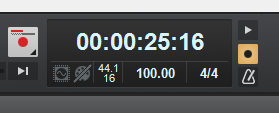I don't often record 'live' into Cakewalk, but today I played my soprano saxophone, added EW Space (Brass default) and did a Low pass filter with the EQ,
The playback, both on export and when played back in track view is about a whole tone lower than played live. I can't be sure of the actual difference but it's significant, and I've double-checked by playing live along with the track in Cakewalk and in Windows media player.
I've read in this forum, that it could be due to a sample rate mismatch, but I'm not sure what needs to be matched. The default sample rate under 'preferences' is set to 4800, and that's the same as the export sample rate.
UPDATE: I've just checked the control panel and sample rate is showing as 44.1. However, when I click on it and go to preferences it shows default set to 4800 (see screenshots).
Could it be that it should be matched to the audio interface - a Berhinger UMC22? Or something else?
Any advice on how and where to set the sample rate would be appreciated (in newbie speak please), or thoughts on anything else I could try to fix it, is appreciated.
Question
Stephen Power
I don't often record 'live' into Cakewalk, but today I played my soprano saxophone, added EW Space (Brass default) and did a Low pass filter with the EQ,
The playback, both on export and when played back in track view is about a whole tone lower than played live. I can't be sure of the actual difference but it's significant, and I've double-checked by playing live along with the track in Cakewalk and in Windows media player.
I've read in this forum, that it could be due to a sample rate mismatch, but I'm not sure what needs to be matched. The default sample rate under 'preferences' is set to 4800, and that's the same as the export sample rate.
UPDATE: I've just checked the control panel and sample rate is showing as 44.1. However, when I click on it and go to preferences it shows default set to 4800 (see screenshots).
Could it be that it should be matched to the audio interface - a Berhinger UMC22? Or something else?
Any advice on how and where to set the sample rate would be appreciated (in newbie speak please), or thoughts on anything else I could try to fix it, is appreciated.

Edited by Stephen Power17 answers to this question
Recommended Posts
Please sign in to comment
You will be able to leave a comment after signing in
Sign In Now